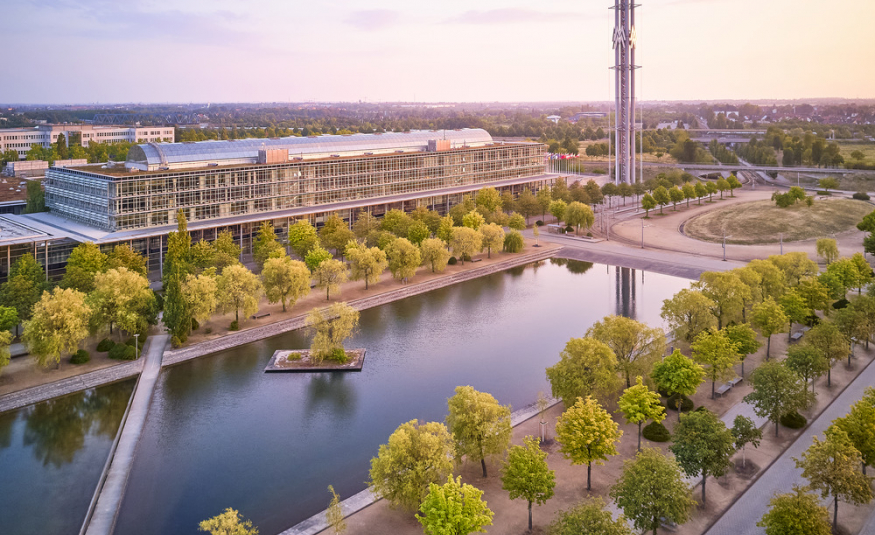2025 will be a year of celebration at Leipziger Messe. There are several anniversaries on the calendar of the oldest trade fair city in the world. Leipzig was granted city status and market rights in 1165 – the foundation stone for the 860-year history of Leipzig trade fairs.
The anniversary of an innovation with which Leipzig wrote trade fair history will also be celebrated: the first sample fair was held here in 1895. The new concept replaced goods fairs and 130 years later still forms the basis of modern trade fairs worldwide. This impressive past is connected to its successful present: with its 'Sample Fair 4.0' strategy, Leipziger Messe intends to continue its dynamic upswing in the coming years.
What lies behind the 'Sample Fair 4.0' strategy
The key strategic components of the company’s development are increased new business and the consistent internationalisation of events, a focus on service orientation, investment in the modernisation of infrastructure and digitalisation, as well as the further development of its sustainability strategy.

A few examples show exactly what this should look like: the key-phrase is new business. By developing new formats, making acquisitions and cooperating with new contractual partners, new business is boosted and the portfolio expanded. Leipziger Messe is focusing on the continuing internationalisation of its events. New for 2024 is the cooperation between Leipziger Messe International GmbH (LMI) and the Kazakh trade fair company AstanaExpo for the Kazakhstan Machinery Fair, Central Asia’s leading industrial trade fair for mechanical engineering.
The goal of the cooperation between the two trade fair companies is the internationalisation of the trade fair. LMI and the Turkish trade fair company TG Expo International Fairs are also jointly organising the first edition of Heritage Middle East, a trade fair for technology and equipment for museums, exhibition centres and libraries in Abu Dhabi (United Arab Emirates) in December.
The trade fair focuses on technology and equipment for museums, exhibition centres and libraries. The design and construction of new exhibition centres, interactive exhibition concepts, sustainability, the interplay between culture/cultural heritage and tourism development, as well as the restoration of buildings and ancient artefacts, will also be in focus.

Leipziger Messe is investing in the modernisation and digitalisation of the site with a variety of individual measures. These include the commissioning of the photovoltaic system on the roof, the renewal of the entire building management system and the introduction of digital signage.
A response to the challenges of today: sustainability
The sustainability campaign is an important part of the ‘Sample Fair 4.0’ strategy. Under the slogan ‘Growing in Balance’, Leipziger Messe is investing in sustainable energy, among other things. Back in 2009, it was the first German trade fair organiser to receive the renowned Green Globe environmental and sustainability seal and has been recertified every year since. Latest milestones: the trade fair company has been using 100% green electricity since 2023 and commissioned a rooftop photovoltaic system in May 2024 covering 15% of its internal electricity requirements. A professional sustainability management system records, evaluates, coordinates and documents all measures.
In the past and future: a platform for innovations
Leipziger Messe’s impressive past gives it the impetus to continue to be a platform for business and trade as well as an economic and innovative driving force with trade fairs, congresses, conferences and exhibitions in the future. With its five subsidiaries, the Congress Center Leipzig (CCL) and the KONGRESSHALLE am Zoo Leipzig, Leipziger Messe covers the entire event business chain as a comprehensive service provider.

Every year, more than 250 events – trade fairs, exhibitions and congresses – take place at its locations with over 15,300 exhibitors and more than 1.2m visitors. This makes Leipziger Messe one of the ten leading trade fair companies in Germany, one of the top 50 worldwide and a driver of innovation and growth in the region.
A brief look at the beginnings of Leipzig trade fairs
As one of the oldest trade fair centres in the world, Leipziger Messe has always stood for the interaction between politics, business and society, for the exchange of goods and ideas, for innovation and for solutions to issues of the future. The anniversary year 2025 commemorates the beginnings of the city, when the settlement at the crossroads of the historic trade routes Via Imperii and Via Regia was granted town status in 1165 – and with it the right to hold a market.
This was followed by princely and imperial privileges, which for centuries gave Leipzig’s fairs a pre-eminent position in the region and beyond. Leipzig also became a favoured trading centre internationally. A large part of the city worked for and lived off the trade fair. This much is certain: no other German trade fair has left its mark on a city like Leipzig’s has.

An idea that goes around the world: the sample fair
The introduction of the sample fair in 1895 was a turning point for Leipzig’s trade fairs and revolutionised fairs worldwide. The new model replaced traditional trade fairs and established Leipzig’s status as an internationally renowned trade fair centre. To this day, presenting samples is the conceptual basis of trade fairs. This milestone has been commemorated by the official logo of Leipziger Messe since 1917: the double M (for “Mustermesse”, or sample fair).
It welcomes visitors to the 85metre-high exhibition tower on the exhibition grounds. It adorns the hat and suitcase of the little trade fair man, the mascot of Leipziger Messe for 60 years. And as a shining landmark on the Wintergartenhochhaus, it is a permanent feature of the Leipzig skyline.





